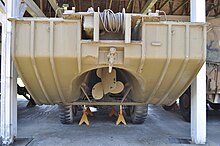Hello ladies and gents this is the viking telling you that today we are going to talk about

 The DUKW was built around the GMC AFKWX, a cab-over-engine (COE) version of the GMC CCKW six-wheel-drive military truck, with the addition of a watertight hull and a propeller. It was powered by a 269.5 cu in (4 l) GMC Model 270 straight-six engine. A five-speed overdrive transmission drove a transfer case for the propeller, then a two-speed transfer case to drive the axles. The propeller and front axle were selectable from their transfer case. A power take-off on the transmission drove an air-compressor and winch.
The DUKW was built around the GMC AFKWX, a cab-over-engine (COE) version of the GMC CCKW six-wheel-drive military truck, with the addition of a watertight hull and a propeller. It was powered by a 269.5 cu in (4 l) GMC Model 270 straight-six engine. A five-speed overdrive transmission drove a transfer case for the propeller, then a two-speed transfer case to drive the axles. The propeller and front axle were selectable from their transfer case. A power take-off on the transmission drove an air-compressor and winch.
DUKW

The DUKW (colloquially known as Duck) is a six-wheel-drive amphibious modification of the 2 1⁄2-ton CCKW trucks used by the U.S. military during World War II and the Korean War.
Designed by a partnership under military auspices of Sparkman & Stephens and General Motors Corporation (GMC), the DUKW was used for the transportation of goods and troops over land and water. Excelling at approaching and crossing beaches in amphibious warfare attacks, it was intended only to last long enough to meet the demands of combat. Surviving DUKWs have since found popularity as tourist craft in marine environments.
History
The DUKW was designed by Rod Stephens, Jr. of Sparkman & Stephens, Inc. yacht designers, Dennis Puleston, a British deep-water sailor resident in the U.S., and Frank W. Speir from the Massachusetts Institute of Technology.[8] Developed by the National Defense Research Committee and the Office of Scientific Research and Development to solve the problem of resupply to units which had just performed an amphibious landing, it was initially rejected by the armed services. When a United States Coast Guard patrol craft ran aground on a sand bar near Provincetown, Massachusetts, an experimental DUKW happened to be in the area for a demonstration. Winds up to 60 knots (110 km/h; 69 mph), rain, and heavy surf prevented conventional craft from rescuing the seven stranded Coast Guardsmen, but the DUKW had no trouble,[9] and military opposition to the DUKW melted. The DUKW later proved its seaworthiness by crossing the English Channel.
The final production design was perfected by a few engineers at Yellow Truck & Coach in Pontiac, Michigan. The vehicle was built by Yellow Truck and Coach Co. (GMC Truck and Coach Div. after 1943) at their Pontiac West Assembly Plant and Chevrolet Div. of General Motors Corp. at their St. Louis Truck Assembly Plant; 21,147 were manufactured before production ended in 1945.
Description
 The DUKW was built around the GMC AFKWX, a cab-over-engine (COE) version of the GMC CCKW six-wheel-drive military truck, with the addition of a watertight hull and a propeller. It was powered by a 269.5 cu in (4 l) GMC Model 270 straight-six engine. A five-speed overdrive transmission drove a transfer case for the propeller, then a two-speed transfer case to drive the axles. The propeller and front axle were selectable from their transfer case. A power take-off on the transmission drove an air-compressor and winch.
The DUKW was built around the GMC AFKWX, a cab-over-engine (COE) version of the GMC CCKW six-wheel-drive military truck, with the addition of a watertight hull and a propeller. It was powered by a 269.5 cu in (4 l) GMC Model 270 straight-six engine. A five-speed overdrive transmission drove a transfer case for the propeller, then a two-speed transfer case to drive the axles. The propeller and front axle were selectable from their transfer case. A power take-off on the transmission drove an air-compressor and winch.
It weighed 13,000 lb (5,900 kg) empty and operated at 50 miles per hour (80 km/h) on road and 5.5 knots (6.3 mph; 10.2 km/h) on water. It was 31 feet (9.45 m) long, 8 feet 3 inches (2.51 m) wide, 7 feet 2 inches (2.18 m) high with the folding-canvas top down and 8 feet 9 inches (2.67 m) high with the top up.
It was not an armored vehicle, being plated with sheet steel between 1⁄16 and 1⁄8 inch (1.6 and 3.2 mm) thick to minimize weight. A high-capacity bilge pump system kept it afloat if the thin hull was breached by holes up to 2 inches (51 mm) in diameter. One in four DUKWs mounted a .50-caliber Browning heavy machine gun on a ring mount.
The DUKW was the first vehicle to allow the driver to vary the tire pressure from inside the cab. The tires could be fully inflated for hard surfaces such as roads and less inflated for softer surfaces, especially beach sand. This added to its versatility as an amphibious vehicle. This feature is now standard on many military vehicles
We hope you liked this post and as always have a chilled day from the viking
Comments
Post a Comment